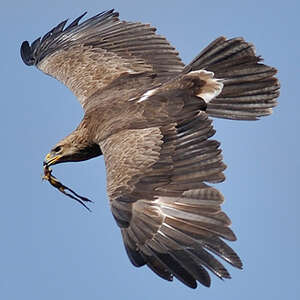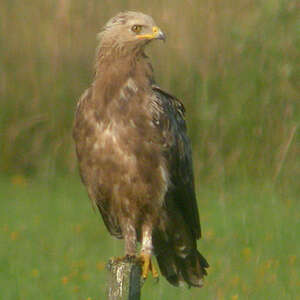Lesser Spotted Eagle
Clanga pomarina - Aigle pomarin
Identification
The Lesser Spotted Eagle is a small dark-plumaged eagle whose specific distinction is relatively recent. Indeed, up to the 19th century, it was mistaken for its current congenerer, the White- bellied Sea-Eagle. If compared to the latter, it is a bit smaller and better proportioned. Its wings are less broad, making its tail appear longer, which is also nicely rounded, or even slightly cuneiform.
The adult plumage is milk chocolate brown, which can seem darker in bad light. In flight, the upperparts are less uniform than in the White-bellied. The dark mantle contrasts with the beige-brown coverts, almost visibly forming a breastplate. The remiges are dark brown with a very visible light flash at the base of the primaries at the level of the hand. The rectrices are also dark brown, highlighting a pale arc, also visible, on the upper-tail. From underneath, the coverts are a warmer and paler brown than the dark brown of the remiges, opposite to that seen in the White-bellied. As in the latter, the undertail is pale.
At rest, and in comparison to the White-bellied, the head is often paler with a more visible yellow eye; the tarsi more tightly plumaged in brown, but the nostrils similarly round.
The juvenile plumage is darker brown, with cream spots at the tips of the greater coverts, both upper and lower, and to a lesser extent of the medium and tertiary coverts, similar to those of the White-bellied but with a much lesser extension, thus less visible. Seen in flight, the spots of the greater coverts form light lines on top and bottom of the wing. Light streaks stripe the lower parts and trousers. The iris is brown. With age, spots and light streaks tend to fade away completely in the adult, while the iris lightens.
Subspecific information monotypic species
Foreign names
- Aigle pomarin,
- Águila pomerana,
- águia-da-pomerânia,
- Schreiadler,
- békászó sas,
- Schreeuwarend,
- Aquila anatraia minore,
- mindre skrikörn,
- Småskrikørn,
- orol krikľavý,
- orel křiklavý,
- Lille Skrigeørn,
- pikkukiljukotka,
- Gevlekte Arend,
- àguila pomerània,
- Gnýörn,
- orlik krzykliwy,
- mazais ērglis,
- mali klinkač,
- Малый подорлик,
- アシナガワシ,
- 小乌雕,
- mindre skrikörn,
- 小烏鵰,
Voice song and call
Habitat
The Lesser Spotted Eagle mainly resides in areas encompassing large forest masses, agricultural sections, and wetlands.
Behaviour character trait
Like the Lesser Spotted Eagle, the behaviour of the Lesser Spotted Eagle is quite nonchalant. Its relatively weak claws make it not well-suited to be a great hunter.
This predator mainly preys on small vertebrates which it hunts by ambushing in open environments. It can also hunt while walking on the ground due to its long and tightly feathered legs. It also often glides above its territory like a buzzard. While it can usually be quite discrete and inconspicuous, during the breeding season during the spring it becomes demonstrative for the courtship.Territorial displays among all birds of prey include dives followed by resources, but the male also performs rapid wing-beats above the level of its body with cries mentioned earlier. One would expect better behaviour from an eagle. The couple, unless otherwise, is united for life. Its life expectancy as an adult is between 25 and 30 years. The pair rules over a rather extensive territory.
Flight
The Lesser Spotted Eagle prefers to soar whenever possible. He soars with his wings tucked underneath his body at an angle, making him immediately distinguishable from a buzzard, which soars with wings open in a 'V' formation. He systematically uses soaring during migration, seeking rising air as other soaring raptors do. His flapping flight is graceful and sweeps with ample strokes, similar to the marsh harrier.
Dietfeeding habits
The basic diet consists of small vertebrates, primarily small mammals such as voles. In this way, its ecology is similar to that of the Buzzard.
It takes advantage of wetland areas to hunt amphibians, mostly frogs, just like the French couple whose nesting site overlooks a lake and marsh. It actually adapts its predation to local resources. In the south of its range, the diet thus includes more reptiles than in the north. It is not really designed to hunt birds, and when it does, it is opportunistically when the circumstances are favorable, for example by hunting young Red-billed Quelea, a species that is always very popular in Africa (source HBW).Reproduction nesting
Nesting is arboreal. The nest is located inside a large forest, far from the edges. It is made of twigs and built in the upper part of a tall tree, more than 10 m from the ground.
The return of the adults takes place in April. Once the area is charged, the female deposits two whitish eggs spotted with brown. The incubation lasts 40 days, assured by the female who begins to incubate as soon as the first egg is laid. Most of the time, only one chick will survive and leave the nest at around 2 months old. It will become independent three to four weeks later. The departure on migration will occur from mid-September.
In the west of the area, cases of hybridization with the Lesser Spotted Eagle are frequent and increasing.
Geographic range
The Lesser Spotted Eagle is endemic to the western Palearctic. Compared to the Common Buzzard, it has a restricted distribution in the heart of the European continent. Its breeding range extends mainly at medium latitudes, from Germany to the west of Russia and the Baltic Sea to the Eastern Mediterranean. Marginal populations are found in Anatolia and in the Caucasus. More anecdotally, an isolated pair has been breeding in eastern France since 2003, and there are indications of possible breeding in northeastern Algeria.
It is a long distance migrant. Its wintering range, very southern, extends from Sudan to South Africa. Most of the population passes through the Bosporus Strait where the migration can take on a spectacular aspect on big passage days. The migrants then cross Egypt.
Threats - protection
IUCN conservation status
concern
in the Wild
threatened
evaluated
For now, the species is not globally threatened, even though it is in strong decline in several countries. Over the last two centuries, its area has diminished on its western margin. This eagle used to nest in eastern France up until the beginning of the 19th century before it was chased away as a result of the systematic persecution of the time. The species has also experienced much decline in Germany and is now only found in the eastern part of the country. From around 100,000 birds in the 80's, the total population has halved in 25 years. Latvia and Belarus are now its main strongholds. The species is very sensitive to changes in its habitats due to the optimization of forestry management, the banalisation of agricultural landscapes, the intensive use of pesticides and the alteration of wetlands. Thus, its situation could continue to worsen. Another negative factor is the destruction of migrating birds by shooting in some countries along migratory pathways, which could affect the species' demographics. It is thus important to stay watchful of its wellbeing.
Sources of information
- IOC World Bird List (v15.1), Gill, F and D Donsker (Eds). 2025-12-07.
Other sources of interest
 Specification sheet created on
26/07/2023 by Jean François
Specification sheet created on
26/07/2023 by Jean FrançoisTranslation by AI Oiseaux.net
© 1996-2026 Oiseaux.net
- Accipitriformes
- Aegotheliformes
- Anseriformes
- Apodiformes
- Apterygiformes
- Bucerotiformes
- Caprimulgiformes
- Cariamiformes
- Casuariiformes
- Charadriiformes
- Ciconiiformes
- Coliiformes
- Columbiformes
- Coraciiformes
- Cuculiformes
- Eurypygiformes
- Falconiformes
- Galliformes
- Gaviiformes
- Gruiformes
- Leptosomiformes
- Mesitornithiformes
- Musophagiformes
- Nyctibiiformes
- Opisthocomiformes
- Otidiformes
- Passeriformes
- Pelecaniformes
- Phaethontiformes
- Phoenicopteriformes
- Piciformes
- Podargiformes
- Podicipediformes
- Procellariiformes
- Psittaciformes
- Pterocliformes
- Rheiformes
- Sphenisciformes
- Steatornithiformes
- Strigiformes
- Struthioniformes
- Suliformes
- Tinamiformes
- Trogoniformes
































